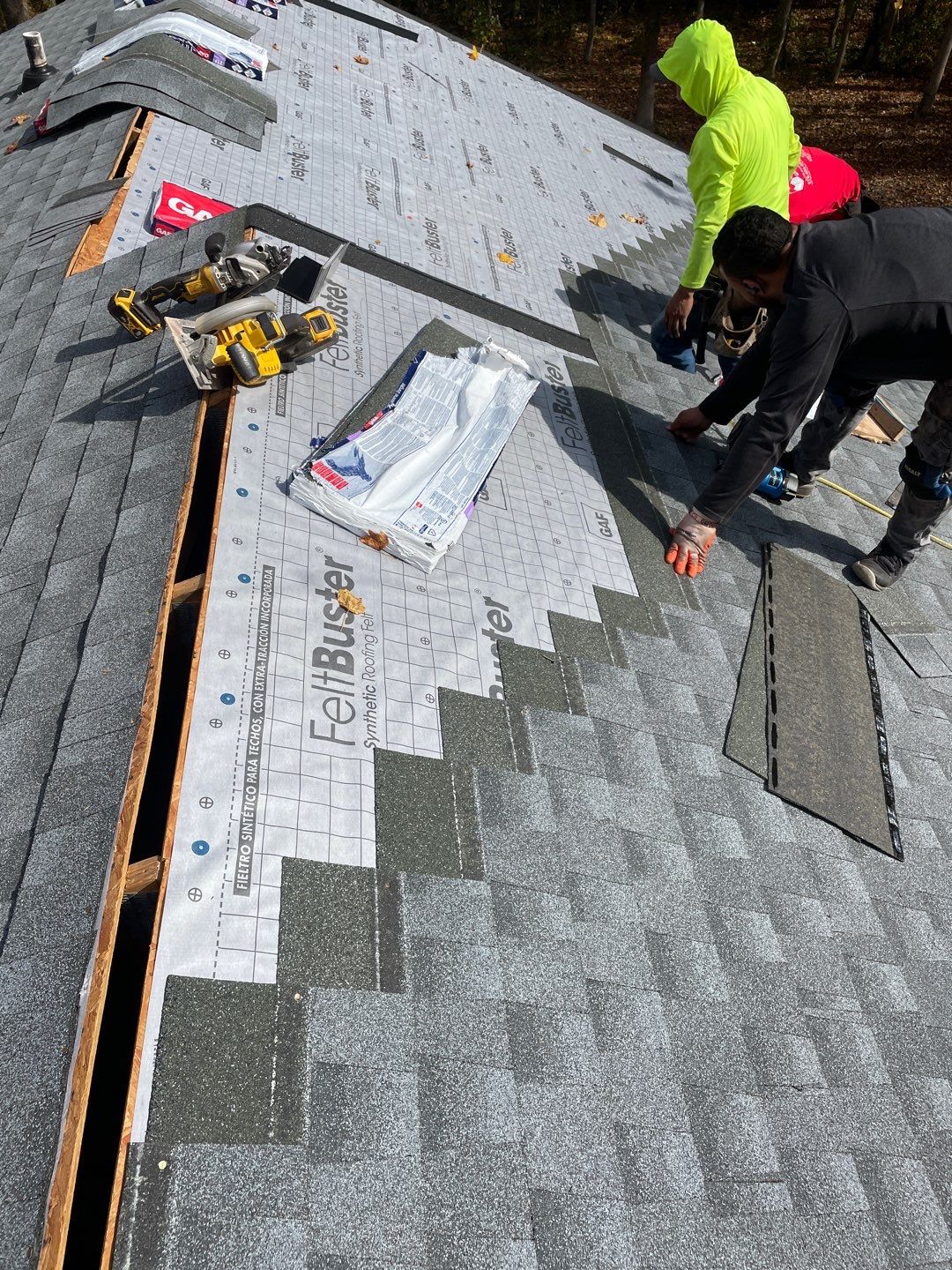Client Testimonials on the most effective Gainesville FL Roofing Companies Offered
Client Testimonials on the most effective Gainesville FL Roofing Companies Offered
Blog Article
Ideal Practices for Ensuring Proper Roof Covering Air Flow
Making sure correct roof ventilation is critical for the long life and effectiveness of a roofing system. A well balanced intake and exhaust air vent proportion, commonly 1:300, plays an essential function, with consumption vents preferably positioned at the lower side of the roof covering for great air entry and exhaust vents at the height for warm air leave. Normal evaluations to identify obstructions and maintain clear air movement are critical. Maintaining insulation away from vents is essential to avoid air movement restriction. Understanding these foundational components sets the phase for more thorough insights right into installation and maintenance methods that can considerably enhance your roofing system's performance.
Understand Air Flow Essentials
Correctly comprehending air flow essentials is important for making certain the long life and effectiveness of roof. Efficient ventilation minimizes moisture build-up and temperature level extremes in the attic, both of which can lead to substantial structural damage with time. A well-ventilated roof covering helps in protecting against typical problems such as mold and mildew development, wood rot, and ice dams, which can compromise the integrity of the roofing materials and the underlying frameworks.
The main goal of ventilation is to assist in the activity of air, enabling a constant exchange between the outside and indoor atmospheres. This equilibrium is achieved with a mix of consumption and exhaust vents that function together to preserve optimum airflow. Intake vents, normally located along the eaves or soffits, enable fresh air to enter the attic room, while exhaust vents, often located at or near the roofing system ridge, enable hot, humid air to get away.
Secret variables affecting the performance of roofing system air flow consist of proper placement, appropriate sizing, and ensuring that both intake and exhaust vents are unblocked. Normal examination and upkeep are important to identify potential obstructions, damages, or inefficiencies in the air flow system, therefore safeguarding the roof's efficiency and longevity.
Types of Roof Vents
Roofing vents play an important duty in preserving effective attic air flow and, by expansion, the general health of the roof system. Various sorts of roofing vents are offered, each with distinct advantages tailored to details roof covering needs. Ridge vents, as an example, are set up along the roof covering's top, permitting cozy, humid air to escape from the attic. They provide continual ventilation and mix seamlessly with the roofline, making them both efficient and cosmetically pleasing.

Soffit vents are set up under the eaves and job in tandem with roof vents to make certain a balanced consumption and exhaust system. By enabling cooler air to get in from below, soffit vents facilitate the expulsion of warm air through upper vents. Gable vents, located on the outside wall surfaces of the attic, offer another effective solution, particularly in homes with saddleback roofs.
Assess Your Present Ventilation

Next, consider the age and condition of your roof products and air flow components. Older systems might not follow current building codes or might have worn away gradually, minimizing their efficiency. Conduct a complete assessment to recognize any type of indications of damage, such as corrosion, damages, or voids that can jeopardize the system's efficiency.
Additionally, measure the attic temperature level and humidity levels. High temperatures and moisture can show insufficient ventilation - roofing companies. Make use of a hygrometer and thermostat to acquire exact analyses, comparing them with outside conditions. Consistent inconsistencies recommend possible concerns that need resolving.
Installment Best Practices
Reliable installation of roofing air flow systems is critical for guaranteeing optimal efficiency and durability. Correct setup begins with recognizing the details ventilation demands of the roofing system and the structure it covers. This entails computing the right ratio of consumption to wear down vents, commonly sticking to the 1:300 policy, which stipulates one square foot of air flow for every single 300 square feet of attic room floor room.

The positioning of vents is equally crucial. Consumption vents should be installed at the roof's reduced side, frequently in the soffits, to permit great air to get in. Exhaust vents, on the other hand, must be set up near or at the roof's peak to help with the departure of warm, moist air. This creates an all-natural airflow that helps keep temperature level and moisture equilibrium within the attic area.
Seal all vent links diligently to avoid air leakages and possible water infiltration. Usage premium materials and comply with producer guidelines to make sure resilience and effectiveness. Additionally, integrating ridge vents with baffles can considerably enhance air flow effectiveness by preventing wind-driven rainfall and snow from getting in the attic room.
Inevitably, exact setup of roofing air flow systems alleviates potential problems such as mold and mildew growth, ice dams, and structural damages, making certain the roof's stability and the building's general wellness.
Regular Upkeep Tips
Uniformity in maintenance techniques is essential to look at this now guaranteeing the long-term performance of roof air flow systems. Normal assessments are essential, preferably executed biannually-- in the spring and loss. Throughout these assessments, make sure that vents are devoid of particles, nests, and other obstructions that can hamper airflow. Check for any kind of signs of dampness buildup or mold, as these can try this web-site suggest improper ventilation or leakages (gainesville fl roofing companies).
Cleaning the vents is an additional essential job. Utilize a soft brush or a vacuum cleaner to remove dust and particles from intake and exhaust vents. Beware not to damage the vent displays or louvers during the process. Furthermore, check the attic room area for any type of signs of water damages, which can endanger the honesty of the roof.
Proper insulation is equally essential. Make sure that attic room insulation does not block the vents, as this can seriously limit air movement. Rearrange or replace it to preserve an effective obstacle. if any kind of insulation has moved or settled.
Lastly, change any type of harmed or missing out on elements quickly. Broken vents, fractured shingles, or scrubby flashing can all add to poor air flow and ought to be dealt with without hold-up. Normal upkeep makes certain that the roof air flow system operates ideally, thereby expanding the lifespan of the roofing itself.
Conclusion
Ensuring appropriate roof ventilation is paramount for preserving the performance and durability of a roof system. Adherence to the 1:300 intake and exhaust vent ratio, paired with the tactical placement of vents, is crucial.
A well balanced consumption and exhaust air vent ratio, frequently 1:300, plays a crucial duty, with intake vents preferably placed at the lower side of the roofing system for awesome air entrance and exhaust vents at the height for warm air exit. Intake vents, typically located along the soffits or eaves, allow fresh air to enter the attic room, while exhaust vents, navigate to this site commonly situated at or near the roof ridge, make it possible for hot, moist air to escape.
Soffit vents are set up under the eaves and job in tandem with roof vents to guarantee a balanced consumption and exhaust system. By allowing cooler air to enter from below, soffit vents facilitate the expulsion of hot air with upper vents. Adherence to the 1:300 consumption and exhaust vent ratio, coupled with the strategic positioning of vents, is vital.
Report this page